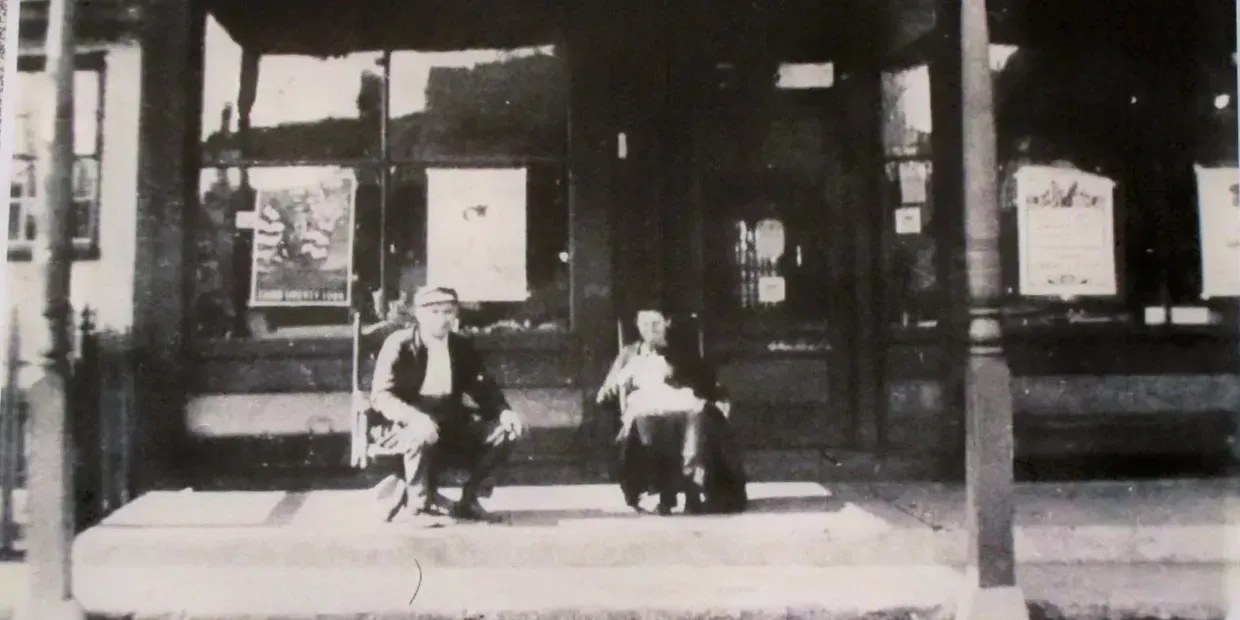History of Bethalto

1918. Henry and Lida Zimmerman in front of their General Store on what is now Central St.
Their store also served as the local Post Office with Mr. Zimmerman serving as Postmaster for 9 years.
MADISON COUNTY GEN-WEB HISTORY OF BETHALTO
The Early History of Bethalto
Bethalto was laid out by Joel U. Starkey, and the plat was recorded June 23, 1854. Part of the town is in Wood River Township, with the eastern part in Fort Russell Township. The town was first named Bethel, but when the post office was established it was discovered another town of the same name already existed in Illinois, and the name was changed to Bethalto (a combination of Bethel and Alton).
The first building in Bethalto was a board shanty, sixteen feet square, on Oak Street, erected by Thomas Smith in 1854. Mr. Smith used it as a dwelling, and also kept a small stock of groceries. The next business house was built by William Tyron in the spring of 1855. It was a frame building, 30x40, and was on Prairie Street. Mr. Tyron had a general stock of goods, and continued his business for some years. The next industry in Bethalto was a brick yard, established by John A. Miller in the spring of 1856, located north of the railroad on the corner of Mill and Oak Streets. That same spring, the firm of Hamilton & Piggett erected a steam circular saw mill on the north side of the railroad on Oak Street, between Second and Third. At that time, Bethalto and the nearby countryside was covered with heavy timber, and the mill flourished and did a thriving business. After a few years timber became scarce, and the mill was moved to Hamel Township.
William Tyron kept the first post office in 1855. The first hotel was built and kept by Anthony B. Carroll in 1858. This hotel was located on Prairie Street, north of the railroad. The first blacksmiths were the firm of Richard & Samuels, which was established in 1856, and was located on Second and Oak Streets, north of the railroad. The first church was erected by the Catholics, and dedicated in the summer of 1862. It was a frame structure. The first Justice of the Peace of Bethalto was John A. Miller.
Bethalto was incorporated as a town under a special act in force, April 19, 1869. The first officers were: Jacob Huppert, President of the board; trustees John P. Richards, J. P. Cumming, J. C. Baugert, and John Jackson. On April 23, 1873, an election was held to determine whether the town should incorporate as a village under general law. The result was in favor of organization, and on May 5, 1873, an election was held to choose village officers. The following were elected: Stephen A. Albro, President of the Board; Trustees Conrad H. Flick, John V. Richards, Adam Elspermann, Charles Gundall, and John Stolze; Clerk William E. Lehr; Police Magistrate John A. Miller. Frank M. Randle was appointed Village Constable, F. W. Stolze, Superintendent of Streets, and Lewis Kleim, treasurer.
In 1859, the President Merchant Mills and Elevator was established by James Neimrick. It had the capacity of manufacturing 100 barrels of flour daily. In 1877, it was torn down and rebuilt by new owners Meyer & Guye, with a daily capacity of 500 barrels. In 1879, Meyer and Guye both died, and in the following year the mill was leased by E. O. Standard & Co. In January 1881, the mill was purchased by J. W. Kauffman, who increased its capacity to 600 barrels. In 1882, a complete change was made in the grinding apparatus, which was considered far in advance of the old system. The mill was 54x80, five stories high, and had a stone basement. The elevator, in connection with the mill, was 40x80 feet, and 85 feet high. It had the capacity of elevating 15,000 bushels of grain daily, and of storing 70,000 bushels of wheat. A warehouse, 65x150 feet, was nearby, which stored 10,000 barrels of flour. The mill also had a cooper shop, and was located on Mill Street. The President Mills was destroyed by fire in 1882, but was rebuilt. It was destroyed by fire a final time in 1895.
Another mill – the Karnack Mill – was established by Ewan Flick in the fall of 1872, and passed into the hands of the senior member of the firm, J. T. Ewan, in the fall of 1879. It was located on Prairie Street. It was a frame building, two stories high, with a basement. It had an engine room of 16x40 feet. The mill had the capacity of grinding 100 barrels of flour daily.
There were two small coal mines near the suburbs of Bethalto. One was owned by David Brunton, and the other by Michael Mayer. Bethalto was situated over a fine vein of coal, from five to eight feet in thickness, and was obtained by going only about 70 feet below the surface.
The Sheridan House hotel was built in 1882 by Conrad H. Flick. It was a fine brick building, three stories high, with a basement. It contained sixteen guest rooms and two storerooms, with an office and sample room. The building contained a dumb-waiter. It was located on the corner of Third and Oak Streets. There were three other hotels in Bethalto – the Union Hotel, owned by H. J. Hensech; the Bethalto House, owned by John Cooper; and the Cooper’s Exchange, owned by John Husum.
The public hall was located in the second story of the Neisler building. It had a stage, and seated approximately 500 people.
